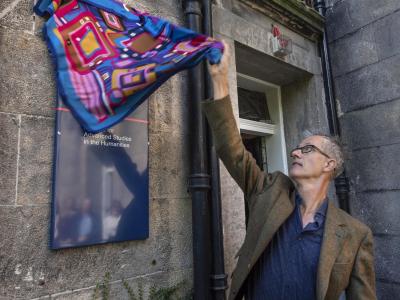
On Saturday 20 August 2022, a host of special guests gathered at IASH for the official unveiling of a commemorative plaque to writer and journalist Dame Rebecca West.
Her childhood home at 2 Hope Park Square is now the Institute's main entrance. Born Cicily Isabel Fairfield in London in 1892, she moved to Hope Park Square with her Scottish mother and sisters in 1902. She lived there for about a year before moving to nearby Buccleuch Place to attend George Watson's Ladies College, then based in George Square. Her memories of poverty in the area strongly informed the portrayal of tenement life that featured in her second novel The Judge, which celebrates its centenary this year.
During her own lifetime, West’s novels drew much less attention than her social and cultural writings. Her reports on the Nuremberg trials of Nazi war criminals, first published in The New Yorker magazine in 1946, were widely acclaimed. By the end of her life, West’s literary reputation had risen considerably. On hearing of her death in 1983, The New Yorker’s editor-in-chief William Shawn described West as “one of the giants who will have a lasting place in English literature”. No-one in the twentieth century, said Shawn, had written more dazzling prose, or displayed more wit.
New Head of College Professor Sarah Prescott welcomed guests including university staff, Fellows, West's family, representatives from West's former school and Historic Environment Scotland, as well as acclaimed writer Geoff Dyer, who was invited to formally unveil the plaque. Dyer provided the foreword to the 2006 reissue by Canongate of her masterpiece Black Lamb and Grey Falcon, and has been a lifelong fan of West's work.
After the unveiling, guests enjoyed a preview of the Institute's forthcoming exhibition of West's personal effects, fittingly displayed in West's former sitting room, now IASH's conference room. The story of her early years and Edinburgh relations, her suffragette campaigning, and her later literary eminence is told through photographs, letters, artworks, postcards, medals and other items kindly loaned by her literary estate. It explores how Edinburgh provided a backdrop and inspiration for West’s thinking, and shaped the author once described by Time magazine as ‘indisputably the world’s No 1 woman writer’. The exhibition will open to the public in the autumn.
IASH would like to thank Geoff Dyer, Professor Sarah Prescott, Historic Environment Scotland, the estate of Rebecca West, Helen Atkinson, Fiona Erskine, Edinburgh City of Literature, George Watson's College, Dr Annabel Williams and especially Dr Karina Williamson, who first spotted the link between 'Hume Park Square' in The Judge and its real-life counterpart. Without her detective work back in 2017, we would never have known about this incredible literary legacy.
